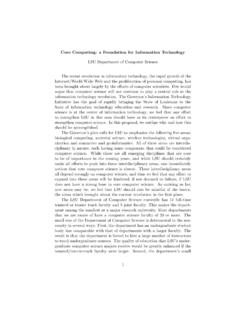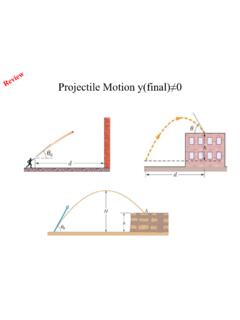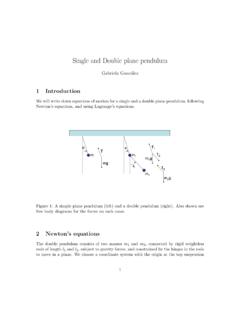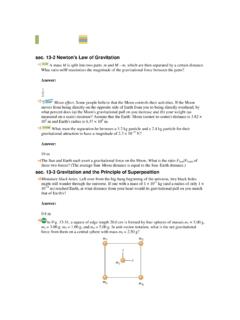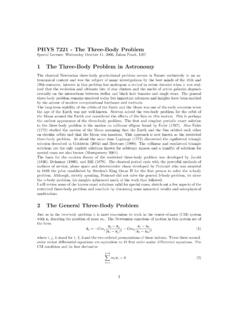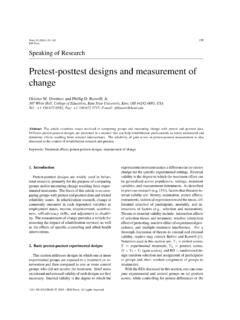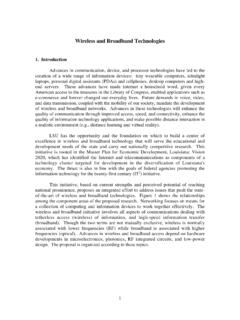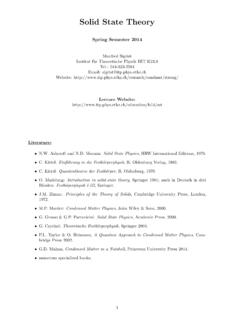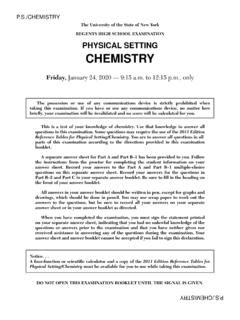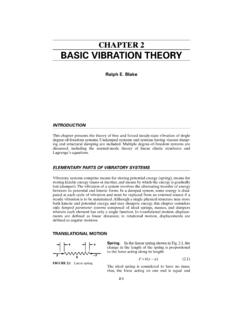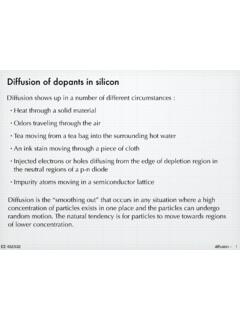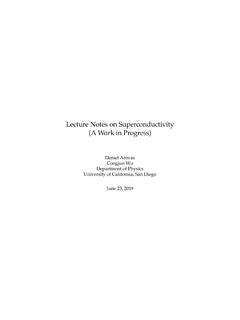Transcription of Chapter 10: Superconductivity
1 Chapter 10: SuperconductivityBardeen, Cooper, & SchriefferApril 26, 2017 Contents1 Evidence of a Phase Transition .. Meissner Effect ..42 The London Equations83 Cooper The Retarded Pairing Potential .. Scattering of Cooper Pairs .. The Cooper Instability of the Fermi Sea ..154 The BCS Ground The Energy of the BCS Ground State .. The BCS Gap ..235 Consequences of BCS and Specific Heat .. Microwave Absorption and Reflection .. The Isotope Effect ..3216 BCS Superconducting Phenomenology337 Coherence of the Superconductor Meisner effects388 Quantization of Magnetic Flux419 Tunnel Junctions4310 Unconventional D-wave Superconductors .. Triplet Superconductors .. Odd-frequency Superconductors ..5421 IntroductionFrom what we have learned about transport, we know that thereis no such thing as an ideal ( = 0) conventional materials have defects and phonons (and to a lessor degreeof importance, electron-electron interactions).
2 As a result, fromour basic understanding of metallic conduction must be finite,even atT= 0. Nevertheless many superconductors, for which = 0, exist. The first one Hg was discovered by Onnes in1911. It becomes superconducting forT < K. Clearly thissuperconducting state must be fundamentally different than the normal metallic state. , the superconducting state mustbe a different phase, separated by a phase transition, from thenormal Evidence of a Phase TransitionEvidence of the phase transition can be seen in the specific heat(See Fig. 1). The jump in the superconducting specific heatCsindicates that there is a phase transition without a latent heat( the transition is continuous or second order). Furthermore,3C (J/mol K)TTcCSC TnFigure 1:The specific heat of a superconductorCSand and normal metalCn. Belowthe transition, the superconductor specific heat shows activated behavior, as if there isa minimum energy for thermal activated nature of C forT < TcCs e (1)gives us a clue to the nature of the superconducting state.
3 It isas if excitations require a minimum energy . Meissner EffectThere is another, much more fundamental characteristic whichdistinguishes the superconductor from a normal, but ideal, con-ductor. The superconductor expels magnetic flux, ie.,B= 04within the bulk of a superconductor. This is fundamentally dif-ferent than an ideal conductor, for which B= 0 since for anyclosed pathCSSuperconductorFigure 2:A closed path and the surface it contains within a =IR=V= E dl= S E dS= 1c S B t dS,(2)or, since S and C are arbitrary0 = 1c B S B= 0(3)Thus, for an ideal conductor, it matters if it is field cooled orzero field cooled. Where as for a superconductor, regardlessof the external field and its history, ifT < Tc, thenB= 0inside the bulk. This effect, which uniquely distinguishes anideal conductor from a superconductor, is called CooledField CooledB = 0B = 0B = 0B 0B 0B 0T < TcT < TcT < TcT < TcT > TcT > TcIdeal ConductorFigure 3:For an ideal conductor, flux penetration in the ground state depends onwhether the sample was cooled in a field through the this reason a superconductor is an ideal diamagnet.
4 H= 0 = 0M= H= 14 H(4) SC= 14 (5)Ie., the measured , Fig. 4, in a superconducting metal is verylarge and negative (diamagnetic). This can also be interpreted6 0T Tc D(E )PauliF4 -1 HMjsFigure 4:LEFT: A sketch of the magnetic susceptibility versus temperature of a su-perconductor. RIGHT: Surface currents on a superconductor are induced to expel theexternal flux. The diamagnetic response of a superconductor is orders of magnitudelarger than the Pauli paramagnetic response of the normal metal atT > TCas the presence of persistent surface currents which maintain amagnetization ofM= 14 Hext(6)in the interior of the superconductor in a direction oppositeto the applied field. The energy associated with this currentsincreases withHext. At some point it is then more favorable(ie., a lower free energy is obtained) if the system returns to anormal metallic state and these screening currents abate.
5 Thusthere exists an upper critical 5: Superconductivity is destroyed by either raising the temperature or by ap-plying a magnetic London EquationsLondon and London derived a phenomenological theory of su-perconductivity which correctly describes the Meissner assumed that the electrons move in a frictionless state, sothatm v= eE(7)or, since j t= ens v, js t=e2nsmE(First London Eqn.)(8)8 Then, using the Maxwell equation E= 1c B t mnse2 js t+1c B t= 0(9)or t(mnse2 js+1cB)= 0(10)This described the behavior of an ideal conductor (for which = 0), but not the Meissner effect. To describe this, theconstant of integration must be chosen to be zero. Then js= nse2mcB(Second London Eqn.)(11)or defining L=mnse2, the London Equations becomeBc= L jsE= L js t(12)If we now apply the Maxwell equation H=4 cj B=4 c jthen we get ( B) =4 c j= 4 c2 LB(13)and ( j) = 1 Lc B= 4 c2 Lj(14)or since B= 0, j=1c t= 0 and ( a) = ( a) 2awe get9 2B 4 c2 LB= 0 2j 4 c2 Lj= 0(15)BSCj B z xs z Bxxyz j^^Figure 6:A superconducting slab in an external field.
6 The field penetrates into theslab a distance L= mc24 ne2 .Now consider a the superconductor in an external field shownin Fig. 6. The field is only in the x-direction, and can vary inspace only in the z-direction, then since B=4 c j, thecurrent is in the y-direction, so 2Bx z2 4 c2 LBx= 0 2jsy z2 4 c2 Ljsy= 0(16)with the solutionsBx=B0xe z Ljsy=jsye z L(17) L= c2 L4 = mc24 ne2 is the penetration Cooper PairingThe superconducting state is fundamentally different than anypossible normal metallic state (ie a perfect metal atT= 0).Thus, the transition from the normal metal state to the super-conducting state must be a phase transition. A phase transitionis accompanied by an instability of the normal state. Cooperfirst quantified this instability as due to a small attractive(!?)interaction between two electrons above the Fermi The Retarded Pairing PotentialThe attraction comes from the exchange of phonons.
7 The lat-v 10 cm/sF8+++++++++++region of positive charge attracts a second electronions ++++e-e-Figure 7:Origin of the retarded attractive potential. Electrons at the Fermi surfacetravel with a high velocityvF. As they pass through the lattice (left), the positive ionsrespond slowly. By the time they have reached their maximum excursion, the firstelectron is far away, leaving behind a region of positive charge which attracts a deforms slowly in the time scale of the electron. It reachesits maximum deformation at a time 2 D 10 13s after theelectron has passed. In this time the first electron has traveled vF 108cms 10 13s 1000 A. The positive charge ofthe lattice deformation can then attract another electron with-out feeling the Coulomb repulsion of the first electron. Dueto retardation, the electron-electron Coulomb repulsion may beneglected!
8 The net effect of the phonons is then to create an attrac-tive interaction which tends to pair time-reversed quasiparticlestates. They form an antisymmetric spin singlet so that thee e 1000 k - k Figure 8:To take full advantage of the attractive potential illustrated in Fig. 7, thespatial part of the electronic pair wave function is symmetric and hence nodeless. Toobey the Pauli principle, the spin part must then be antisymmetric or a part of the wave function can be symmetric and nodeless12and so take advantage of the attractive interaction. Further-more they tend to pair in a zero center of mass (cm) state sothat the two electrons can chase each other around the Scattering of Cooper PairsThis latter point may be quantified a bit better by consideringtwo electrons above a filled Fermi sphere. These two electronsare attracted by the exchange of phonons.
9 However, the max-imum energy which may be exchanged in this way is h the scattering in phase space is restricted to a narrowshell of energy width h , the momentum ink 2k1k2k 1k 1k1k2k 2 DE k2kFigure 9:Pair states scattered by the exchange of phonons are restricted to a narrowscattering shell of width h Daround the Fermi scattering process is also conservedk1+k2=k 1+k 2=K(18)Thus the scattering ofk1andk2intok 1andk 2is restricted tothe overlap of the two scattering shells, Clearly this is negligibleunlessK 0. Thus the interaction is strongest (most likely)ifk1= k2and 1= 2; ie., pairing is primarily betweentime-reversed shellFigure 10:If the pair has a finite center of mass momentum, so thatk1+k2=K,then there are few states which it can scatter into through the exchange of a The Cooper Instability of the Fermi SeaNow consider these two electrons above the Fermi surface.
10 Theywill obey the Schroedinger equation. h22m( 21+ 22) (r1r2) +V(r1r2) (r1r2) = ( + 2EF) (r1r2)(19)IfV= 0, then = 0, and V=0=1L3/2eik1 r11L3/2eik2 r2=1L3eik(r1 r2),(20)where we assume thatk1= k2=k. For small V, we willperturb around theV= 0 state, so that (r1r2) =1L3 kg(k)eik (r1 r2)(21)The sum must be restricted so thatEF< h2k22m< EF+ h D(22)this may be imposed byg(k), since|g(k)|2is the probability offinding an electron in a statekand the other in k. Thus wetakeg(k) = 0 for k<kFk> 2m(EF+ h D) h(23)15 The Schroedinger equations may be converted to a k-spaceequation by multiplying it by1L3 d3re ik r (24)so that h2k2mg(k) +1L3 k g(k )Vkk = ( + 2EF)g(k)(25)whereVkk = V(r)e i(k k ) rd3r(26)now describes the scattering from (k, k) to (k , k ). It isusually approximated as a constant for allkandk which obeythe Pauli-principle and scattering shell restrictionsVkk = V0EF< h2k22m, h2k 22m< EF+ h D0otherwise.

